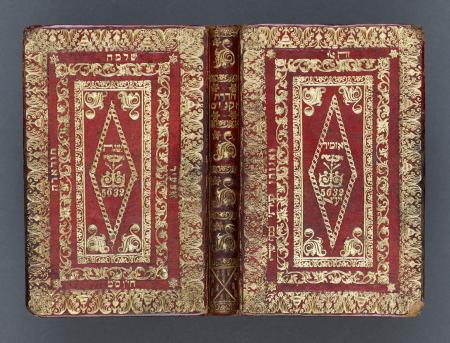Obj. ID: 35359
Jewish printed books Hadarat Zekeinim by Chaim Yosef David Azulai, Livorno, 1867

The following description was prepared by William Gross:
Kabbalistic works, primarily the Idra Rabba and Zutra, The Idra, which means threshing floor in Aramaic, is a Kabbalistic work included in printings of the Zohar, and was probably written and appended to the main body of the Zohar at a later date. Contemporary scholars believe the Idra dates to the third generation of Zoharic literature, which produced also the Tiqqunim, the Ra'aya Meheimna, and other Zoharic material. The main body of the Zohar, or guf ha-zohar, dates to the second generation of Zoharic material. There are actually two texts in Zoharic literature called Idra: the first being the Idra Rabba, or “greater Idra”, and the second being the Idra Zuta, or “lesser Idra”, with these two texts being intimately connected to each other. Idra Rabba ("The Greater Assembly"), a description of the gathering of Simeon b. Yohai and his companions, in which the most profound mysteries are expounded concerning the revelation of the Divine in the form of *Adam Kadmon ("Primordial Man"). It is of a superior literary construction and the most systematic discourse found in the Zohar. Each of the companions says his piece and Simeon b. Yohai completes their pronouncements. At the end of this solemn assembly three of the ten participants meet with an ecstatic death. Among the early kabbalists it was called Idra de-Naso and it is printed in the portion Naso (3:127b–145a). It is, in a way, a kind of Talmud to the Mishnah of the Sifra di-Zeni'uta. The Idra Zuta ("The Lesser Assembly"), a description of the death of Simeon b. Yohai and his closing words to his followers before his death, a kind of kabbalistic parallel to the death of Moses. It contains a companion discourse to that in the Idra Rabba, with many additions. Among the early kabbalists it was called Idra de-Ha'azinu. This portion concludes the Zohar (3:287b–96b).
Rabbi Chaim Joseph David Azulai (Jerusalem 1724 - Leghorn, 1806), known as the Chida, was one of the great scholars of the 18th C. He was an author, traveler and father of modern Hebrew bibliography. Known as the Chidah, he was highly respected for his great piety and scholarship, and wrote no less than 71 works. Thanks to his work many works of other authors came to light.
In 1778, after many years spent as an emissary of the Holy Land to communities abroad, the Chida settled in the quiet and prosperous Jewish community of Livorno (Leghorn), Italy, to begin writing his major works. Livorno was then a center of Hebrew printing. ChIDA found there all the necessary facilities for publishing his works, and generous book lovers who helped him do it. A certain physician, Michael Pereira de Leon, a descendant of one of the oldest Jewish families in Italy, enabled ChIDA to devote all his time to his writings, taking care of all his financial needs.
The printer, R. Yisrael Kushta (1819-1897) was born in Livorno, Italy. He was an author, rabbi and commentator. In 1864, at the age of 45 (three years before this book was published), R. Kushta was appointed chief Rabbi of Livorno, a position he held until his death.




